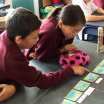Provide options to create, learn and share
Provide flexible options and tools so ākonga can show their learning and share with others.
On this page:
On this page:
Current page section: Provide options to create, learn and share
Go to top of current page: Provide options to create, learn and share
Go to top of current page: Provide options to create, learn and share
Go to top of current page: Provide options to create, learn and share
Offer opportunities to develop conversation skills
Offer opportunities to develop conversation skills
Play, role play and games provide authentic opportunities for ākonga to interact with others and practise being a good communication partner.

Source: Inclusive Education videos
Personalise learning
Personalise learning
Provide opportunities for learners to learn in ways that suit their needs and preferences.
- Set realistic, ambitious, and achievable personal targets.
- Create opportunities where learners can personalise learning tasks and projects to build on their culture, knowledge, experience and strengths.
- Discuss with learners the different ways they can share their thinking and demonstrate understanding.
- Develop success criteria with learners and present them with clear visual supports.
- Provide opportunities for learners to gain confidence using a range of media so they can select the most appropriate way to express their learning.
- Offer a flexible learning environment with a variety of seating and working spaces.
- Offer a reader-writer or assistive technologies to support success in assessments.
Offer options for sharing learning
Offer options for sharing learning
Provide a range of ways for students to express what they know.
For example, using multimedia, talking books, images, symbols, voice recordings and videos.
Closed Captions
Notice, recognise and respond to ākonga progress
Notice, recognise and respond to ākonga progress
Notice ākonga progress in authentic and everyday contexts. Recognise ākonga progress in learning and respond by adapting practice to learning needs.
- Use everyday classroom observations and conversations to notice learning progress.
- Use a progressions based approach to recognise achievement and next steps.
- Respond to learner progress by planning and modifying teaching to meet ākonga needs.
- Use ‘noticing, recognising and responding’ as a basis for reporting ākonga achievements to parents.
- Use real time reporting tools to document student learning as it happens and share progress with whānau. For example, use Student Management System parent portals, apps and shared online platforms.
- Make learning visible. When learning is visible, ākonga know what they need to learn, where they are at with that learning, and what their next learning steps are.
- Empower ākonga to be active participants in recognising their learning progress. For example, co-construct progression and assessment rubrics.
Gather evidence using strengths
Gather evidence using strengths
Speech-language therapist Sally Clendon talks about ways to gather evidence of learning. For example, a student could show their reading knowledge by selecting a word from four choices rather than reading it aloud.
Provide adaptations for assessments
Provide adaptations for assessments
Work with the student, whānau and specialists to identify the best ways for students to demonstrate their learning.
For more information see the checklist at the end of this article:
Emergent Literacy Assessment in Children With Autism Spectrum Disorder Who Have Limited Verbal Communication Skills: A Tutorial, Sally Clendon et.al., LSHSS, vol 52:1, Jan 2021
- Design the assessment environment to maximise success, for example, by providing a quiet space.
- Provide more time.
- Provide non-verbal options for oral narrative tasks, such as point to select and multichoice comprehension questions.
- Offer options like partner-assisted scanning for students who cannot point to select. In partner-assisted scanning, the partner goes through each option asking if it is correct and the student uses a yes response to participate in the assessment.
- Offer options for writing such as a large colour-coded keyboard, iPad writing options, or an alphabet scanning flipchart to spell out responses.
- Offer options for visual complexity such as large text, high contrast colours or filters.
- Offer options for complexity of the task, for example, multichoice activities with 3 options or 6 options.
Source: Adapted from Better Start Literacy Approach (BSLA) video (opens in a new tab/window)
Next steps
More suggestions for implementing the strategy “Helpful classroom strategies years 1-8”:
-
Current page Provide options to create, learn and share
Return to the guide “Speech, Language and Communication”

Speech, Language and Communication
How to use this site
Guide to Index of the guide: Speech, Language and Communication
Strategies for action:
-
Identify needs and how to provide supportShow suggestions for Identify needs and how to provide support
-
Key areas to supportShow suggestions for Key areas to support
-
Helpful classroom strategies years 1-8Show suggestions for Helpful classroom strategies years 1-8
- Build language-rich environments
- Support participation and confidence
- Present information in different ways
- Support processing and planning
- Provide options to create, learn and share
-
Helpful classroom strategies years 9-13Show suggestions for Helpful classroom strategies years 9-13
